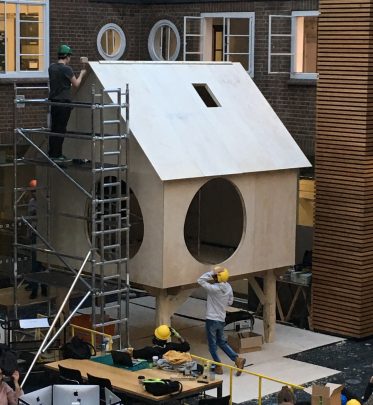
Fujimori tea house made with Hayatsu Architects
News22 March 2017
Terunobu Fujimori's continuing collaboration with Kingston University students
Categorised under: Art & Exhibitions, Grants
In 2015, the Daiwa Anglo-Japanese Foundation awarded a Daiwa Foundation Small Grant to Mr Takeshi Hayatsu, lecturer at the School of Architecture & Landscape, Kingston University and Director of Hayatsu Architects. Hayatsu invited architect and architectural historian Terunobu Fujimori to London to participate in a round-table event on the theme of contemporary crafts held in a pavilion* to be built by Kingston Architecture students at Dorich House Museum in 2016, under Fujimori’s guidance and supervision.
Fujimori was then approached by the Barbican to build a pavilion for the Barbican’s 2017 exhibition The Japanese House: Architecture and Life after 1945 (23 March – 25 June 2017). Having successfully and happily collaborated with Hayatsu, Terunobu asked Hayatsu and his students to work with him once again – this time building a teahouse on legs. The teahouse can be seen in the Barbican’s main gallery space.
The teahouse stands next to the exhibition’s other main project – a 1:1 replica of Moriyama House designed by Ryue Nishizawa – a network of 10 rooms and gardens.
The hand-crafted elements in Fujimori’s teahouse, such as bronze cast door knobs, ceramic hearth, vases and lampshades were all crafted by Kingston University Architecture and Product Design students, and provide an interesting contrast to the more professionally built Moriyama House.
You can read more about Takeshi Hayatsu’s work and practice here.
You can read about The Japanese House: Architecture and Life after 1945 in these newspaper articles:
http://www.cityam.com/261612/japanese-house-review-exhibition-exploring-japanese
https://www.ft.com/content/9dc807cc-04b5-11e7-aa5b-6bb07f5c8e12
*The pavilion made last year for the Dorich House Museum last year was transported to the Weald and Downland Open Air Museum in West Sussex. Pending planning permission, the museum hopes it will remain as a semi-permanent structure.
The Daiwa Anglo-Japanese Foundation is delighted to be supporting The Japanese House: Architecture and Life after 1945 with a Daiwa Foundation Small Grant.